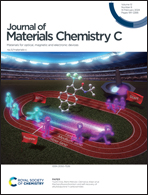Revealing two chemical strategies to tune bright one- and two-photon excited fluorescence of carbon nanodots†
Abstract
Carbon-based dots (CDs) are a novel class of luminescent carbon nanomaterials that have attracted much attention as promising alternatives for cadmium-based quantum dots and fluorescent organic dyes. Although different strategies have been proposed to produce CDs with intense and tuneable one-photon excited fluorescence (OPEF), the case of analogous two-photon excited fluorescence (TPEF) has not been fully explored yet. By varying the synthesis conditions, we produced three types of phloroglucinol-based carbon nanodots (PG CNDs). Their remarkable OPEF and TPEF properties can be tuned by (Ia) the conjugated aromatic domains and (Ib) the content of oxygenous moieties. In addition, the emission colour of the PG CNDs is strongly responsive to (II) the hydrogen-bonding network, enabling colour-switching while maintaining excellent fluorescence yields (both OPEF and TPEF). These three factors were evaluated for their suitability for the tuning of the emission colour. Our studies point out the advantages of the tuneable PG CNDs to be used in optoelectronics and biological application domains.



 Please wait while we load your content...
Please wait while we load your content...